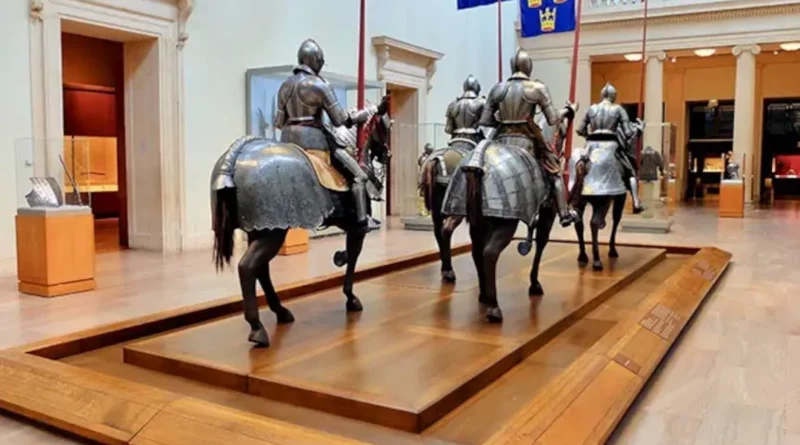Metropolitan Museum Of Art In New York City
The Metropolitan Museum of Art, commonly referred to as “The Met,” is not only the largest art museum in the United States but also one of the most prestigious cultural institutions in the world. Located in New York City, The Met boasts an extensive collection that spans over 5,000 years of art from nearly every culture on the planet. Established in 1870, The Met has grown into a beacon of artistic and cultural heritage, attracting millions of visitors each year.
The History of The Metropolitan Museum of Art
The idea for The Met was conceived by a group of American citizens—including businessmen, artists, and philanthropists—who envisioned a museum to bring art and education to the American people. The museum officially opened its doors in 1872, housed in a building on Fifth Avenue and 82nd Street. The collection initially consisted of 174 European paintings but quickly expanded through acquisitions and donations. Over time, The Met has undergone several expansions, including the construction of new wings and buildings, such as The Met Cloisters in Upper Manhattan, which focuses on medieval European art.
Architectural Marvels of The Met
The Metropolitan Museum of Art is housed in three iconic locations across New York City: The Met Fifth Avenue, The Met Cloisters, and The Met Breuer. Each building represents a unique architectural style and offers visitors a distinct experience.
- The Met Fifth Avenue: This location is the museum’s primary building and is situated on the eastern edge of Central Park. Designed in the Beaux-Arts style, The Met Fifth Avenue is an architectural masterpiece featuring grand staircases, opulent galleries, and a striking facade that has become a symbol of the museum.
- The Met Cloisters: Located in Fort Tryon Park, The Met Cloisters is dedicated to the art and architecture of medieval Europe. The building itself is a reconstructed monastery, with elements sourced from various European sites, creating an authentic medieval atmosphere.
- The Met Breuer: Previously housed in a Brutalist building designed by Marcel Breuer, this branch focused on modern and contemporary art. Though The Met Breuer closed in 2020, its significance in presenting 20th and 21st-century works remains integral to the museum’s legacy.
The Met’s Extensive Art Collections
The Met’s collection is vast and diverse, encompassing over two million works of art across various disciplines and time periods. Each department within the museum specializes in a particular genre or era, offering a comprehensive overview of global art history.
- Ancient Near Eastern Art: This collection includes artifacts from ancient Mesopotamia, Persia, and other early civilizations, featuring items such as cuneiform tablets, sculptures, and jewelry that date back to the dawn of human history.
- Greek and Roman Art: The Met’s Greek and Roman collection is one of the most comprehensive in the world, showcasing sculptures, pottery, and mosaics that span from the Aegean Bronze Age to the fall of the Roman Empire.
- Egyptian Art: The Egyptian Art department houses over 26,000 objects, including mummies, sarcophagi, and the famous Temple of Dendur, which was gifted to the United States by Egypt in 1965.
- Islamic Art: The museum’s Islamic Art collection features over 12,000 objects, ranging from intricate textiles and ceramics to illuminated manuscripts and metalwork, representing the artistic traditions of Islamic cultures across centuries.
- Asian Art: This department covers a vast geographic area, including China, Japan, Korea, South Asia, and Southeast Asia. The collection includes Buddhist sculptures, paintings, ceramics, and decorative arts that illustrate the region’s rich artistic heritage.
- European Paintings: The Met’s European Paintings collection is renowned for its depth and quality, featuring masterpieces by artists such as Rembrandt, Vermeer, Van Gogh, and Monet. The collection spans from the 13th to the 19th century, offering a comprehensive overview of Western art history.
- American Art: The museum’s American Art collection includes works from the colonial period to the early 20th century, showcasing the evolution of American artistic expression through paintings, sculptures, and decorative arts.
Special Exhibitions at The Met
The Met is well-known for its special exhibitions, which often draw large crowds and critical acclaim. These exhibitions are curated to explore specific themes, artists, or periods in greater depth, providing visitors with a unique perspective on the museum’s collections.
- The Met Gala and Costume Institute: One of the most high-profile events hosted by The Met is the annual Met Gala, which serves as a fundraiser for the museum’s Costume Institute. The Gala coincides with a major exhibition at the Costume Institute, showcasing fashion as an art form and exploring the intersections of culture, identity, and design.
- Blockbuster Exhibitions: Over the years, The Met has hosted numerous blockbuster exhibitions, such as the 2018 “Heavenly Bodies: Fashion and the Catholic Imagination,” which became the most visited show in the museum’s history. These exhibitions often feature loaned works from other institutions and private collections, allowing The Met to present rare and significant pieces to the public.
Educational Programs and Initiatives
As a leading cultural institution, The Met is deeply committed to education and public engagement. The museum offers a wide range of educational programs designed to enrich visitors’ understanding of art and culture.
- Workshops and Classes: The Met provides art-making workshops, lectures, and classes for all age groups, from children to adults. These programs are designed to foster creativity and encourage a deeper appreciation for art.
- School Programs: The museum works closely with schools to offer educational visits, guided tours, and curriculum-based programs that align with state and national standards. These initiatives are aimed at making art accessible and relevant to students of all backgrounds.
- Digital Resources: The Met has embraced digital technology to extend its educational reach beyond the museum walls. The museum’s website features an extensive collection of online resources, including virtual tours, art history lessons, and interactive tools that allow users to explore the collection from anywhere in the world.
Conservation and Research at The Met
The Met is not only a repository of art but also a center for conservation and research. The museum’s conservation departments are dedicated to preserving its vast collection, ensuring that the artworks can be enjoyed by future generations.
- Art Conservation: The Met employs a team of conservators who specialize in different materials, such as paintings, textiles, and sculpture. These experts use advanced techniques to analyze and restore artworks, often uncovering new information about their history and creation.
- Scientific Research: The museum also conducts scientific research on its collection, using tools such as X-ray fluorescence, infrared imaging, and chromatography to study the materials and techniques used by artists. This research contributes to a deeper understanding of the works and informs conservation practices.
- The Met’s Libraries and Archives: The museum’s libraries and archives are invaluable resources for scholars and researchers. The Thomas J. Watson Library, one of the largest art libraries in the world, contains over 900,000 volumes, including rare books, periodicals, and auction catalogs. The museum’s archives preserve the institutional history of The Met, providing insight into its development and operations over the years.
The Met and Cultural Diplomacy
Throughout its history, The Met has played an important role in cultural diplomacy, fostering international relationships through art. The museum often collaborates with foreign institutions to organize exhibitions and exchange works of art, promoting cross-cultural understanding and appreciation.
- International Loans and Collaborations: The Met frequently loans pieces from its collection to museums around the world and hosts exhibitions featuring loaned works from other countries. These exchanges allow for a global dialogue on art and culture, bringing diverse perspectives to the museum’s audience.
- Cultural Heritage Preservation: The Met is also involved in efforts to preserve cultural heritage in regions affected by conflict or natural disasters. The museum collaborates with international organizations and local communities to protect and restore endangered artworks and cultural sites, ensuring that these treasures are preserved for future generations.
Visitor Experience at The Met
The Metropolitan Museum of Art offers a rich and varied visitor experience, with something to captivate every type of art lover. Whether you’re a first-time visitor or a seasoned art enthusiast, The Met’s vast collection and diverse programming provide endless opportunities for discovery.
- Guided Tours: The Met offers a range of guided tours, led by knowledgeable docents and curators, that provide insight into the museum’s collection and history. These tours are available in multiple languages and cover various themes and highlights.
- Audio Guides: For those who prefer to explore at their own pace, The Met provides audio guides that offer detailed commentary on select works in the collection. These guides are available for rent at the museum or can be downloaded as a mobile app.
- Dining and Shopping: The museum also features several dining options, including cafes and a rooftop bar, where visitors can enjoy a meal or drink while taking in views of Central Park and the Manhattan skyline. The Met Store offers a wide range of art-inspired merchandise, from books and prints to jewelry and home decor.
The Role of The Met in New York City’s Cultural Scene
As one of New York City’s most iconic landmarks, The Met plays a central role in the city’s cultural scene. The museum is not only a major tourist attraction but also a hub for the local community, offering a wide range of events and programs that reflect the city’s diversity and creativity.
- Cultural Festivals and Events: The Met hosts numerous cultural festivals, performances, and special events throughout the year, celebrating the art and traditions of various communities. These events often feature live music, dance, and workshops, providing a dynamic and immersive experience for visitors.
- Collaboration with Local Artists and Institutions: The Met frequently collaborates with local artists, schools, and cultural organizations to create programming that resonates with New York City’s diverse population. These partnerships help to make the museum’s collection more accessible and relevant to the city’s residents.
The Future of The Metropolitan Museum of Art
As The Met looks to the future, it remains committed to expanding and diversifying its collection, enhancing the visitor experience, and using art as a tool for education and cultural exchange. The museum is continually evolving to meet the needs of its audience and to reflect the ever-changing world of art and culture.
- Expanding the Collection: The Met continues to acquire new works, with a focus on increasing representation of underrepresented artists and cultures. This effort ensures that the museum’s collection remains relevant and inclusive, reflecting the diversity of human creativity.
- Sustainability Initiatives: The museum is also dedicated to sustainability, implementing practices that reduce its environmental impact. These initiatives include energy-efficient building designs, waste reduction programs, and sustainable sourcing for museum operations.
- Digital Expansion: The Met is expanding its digital presence to reach a global audience, offering more online exhibitions, virtual tours, and educational resources. This digital expansion allows the museum to connect with art lovers around the world and to make its collection accessible to those who cannot visit in person.
Conclusion
The Metropolitan Museum of Art is more than just a museum; it is a cultural institution that plays a vital role in the preservation and celebration of human creativity. With its unparalleled collection, rich history, and commitment to education and cultural exchange, The Met continues to inspire and educate millions of visitors each year. Whether you’re exploring ancient artifacts, admiring Renaissance masterpieces, or engaging with contemporary art, The Met offers a unique and enriching experience that leaves a lasting impression.
Discover more from City Towner
Subscribe to get the latest posts sent to your email.




